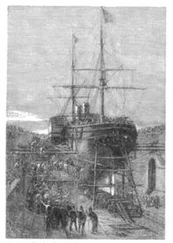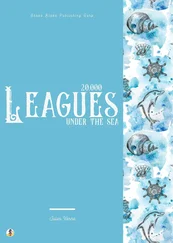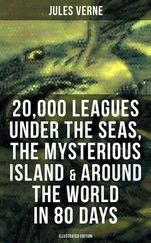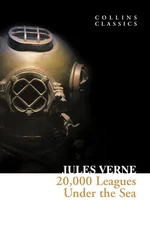Jules Verne - Twenty Thousand Leagues Under the Sea
Здесь есть возможность читать онлайн «Jules Verne - Twenty Thousand Leagues Under the Sea» — ознакомительный отрывок электронной книги совершенно бесплатно, а после прочтения отрывка купить полную версию. В некоторых случаях можно слушать аудио, скачать через торрент в формате fb2 и присутствует краткое содержание. Жанр: sf_writing, на английском языке. Описание произведения, (предисловие) а так же отзывы посетителей доступны на портале библиотеки ЛибКат.
- Название:Twenty Thousand Leagues Under the Sea
- Автор:
- Жанр:
- Год:неизвестен
- ISBN:нет данных
- Рейтинг книги:5 / 5. Голосов: 2
-
Избранное:Добавить в избранное
- Отзывы:
-
Ваша оценка:
- 100
- 1
- 2
- 3
- 4
- 5
Twenty Thousand Leagues Under the Sea: краткое содержание, описание и аннотация
Предлагаем к чтению аннотацию, описание, краткое содержание или предисловие (зависит от того, что написал сам автор книги «Twenty Thousand Leagues Under the Sea»). Если вы не нашли необходимую информацию о книге — напишите в комментариях, мы постараемся отыскать её.
Twenty Thousand Leagues Under the Sea — читать онлайн ознакомительный отрывок
Ниже представлен текст книги, разбитый по страницам. Система сохранения места последней прочитанной страницы, позволяет с удобством читать онлайн бесплатно книгу «Twenty Thousand Leagues Under the Sea», без необходимости каждый раз заново искать на чём Вы остановились. Поставьте закладку, и сможете в любой момент перейти на страницу, на которой закончили чтение.
Интервал:
Закладка:
Jules Verne
Twenty Thousand Leagues Under the Sea
1873 Press
Contents
Part 1
A Shifting Reef
Pro and Con
I Form My Resolution
Ned Land
At a Venture
At Full Steam
An Unknown Species of Whale
Mobilis in Mobili
Ned Land's Tempers
The Man of the Seas
All by Electricity
Some Figures
The Black River
A Note of Invitation
A Walk on the Bottom of the Sea
A Submarine Forest
Four Thousand Leagues Under the Pacific
Vanikoro
Torres Straits
A Few Days on Land
Captain Nemo's Thunderbolt
'?gri Somnia'
The Coral Kingdom
Part 2
The Indian Ocean
A Novel Proposal of Captain Nemo's
A Pearl of Ten Millions
The Red Sea
The Arabian Tunnel
The Grecian Archipelago
The Mediterranean in Forty-Eight Hours
Vigo Bay
A Vanished Continent
The Submarine Coal Mines
The Sargasso Sea
Cachalots and Whales
The Iceberg
The South Pole
Accident or Incident?
Want of Air
From Cape Horn to the Amazon
The Poulps
The Gulf Stream
From Latitude 47 24' to Longitude 17 28'
A Hecatomb
The Last Words of Captain Nemo
Conclusion
Part 1
A Shifting Reef
The year 1866 was signalized by a remarkable incident, a mysterious and inexplicable phenomenon, which doubtless no one has yet forgotten. Not to mention rumors which agitated the maritime population, and excited the public mind, even in the interior of continents, seafaring men were particularly excited. Merchants, common sailors, captains of vessels, skippers, both of Europe and America, naval officers of all countries, and the governments of several states on the two continents, were deeply interested in the matter.
For some time past, vessels had been met by "an enormous thing," a long object spindle-shaped, occasionally phosphorescent, and infinitely larger and more rapid in its movements than a whale.
The facts relating to this apparition (entered in various log-books) agreed in most respects as to the shape of the object or creature in question, the untiring rapidity of its movements, its surprising power of locomotion, and the peculiar life with which it seemed endowed. If it was a cetacean, it surpassed in size all those hitherto classified in science. Taking into consideration the mean of observations made at divers times-rejecting the timid estimate of those who assigned to this object a length of two hundred feet, equally with the exaggerated opinions which set it down as a mile in width and three in length-we might fairly conclude that this mysterious being surpassed greatly all dimensions admitted by the ichthyologists of the day, if it existed at all. And that it did exist was an undeniable fact; and, with that tendency which disposes the human mind in favor of the marvelous, we can understand the excitement produced in the entire world by this supernatural apparition. As to classing it in the list of fables, the idea was out of the question.
On the 20th of July, 1866, the steamer Governor Higginson, of the Calcutta and Burnach Steam Navigation Company, had met this moving mass five miles off the east coast of Australia. Captain Baker thought at first that he was in the presence of an unknown sand-bank; he even prepared to determine its exact position, when two columns of water, projected by the inexplicable object, shot with a hissing noise a hundred and fifty feet up into the air. Now, unless the sand-bank had been submitted to the intermittent eruption of a geyser, the Governor Higginson had to do neither more nor less than with an aquatic mammal, unknown till then, which threw up from its blow-holes columns of water mixed with air and vapor.
Similar facts were observed on the 23d of July in the same year, in the Pacific Ocean, by the Columbus, of the West India and Pacific Steam Navigation Company. But this extraordinary cetaceous creature could transport itself from one place to another with surprising velocity; as, in an interval of three days, the Governor Higginson and the Columbus had observed it at two different points of the chart, separated by a distance of more than seven hundred nautical leagues.
Fifteen days later, two thousand miles further off, the Helvetia, of the Compagnie-Nationale, and the Shannon, of the Royal Mail Steamship Company, sailing to windward in that portion of the Atlantic lying between the United States and Europe, respectively signaled the monster to each other in 42 15' N. lat. and 60 35' W. long. In these simultaneous observations, they thought themselves justified in estimating the minimum length of the mammal at more than three hundred and fifty feet, as the Shannon and Helvetia were of smaller dimensions than it, though they measured three hundred feet over all.
Now the largest whales, those which frequent those parts of the sea round the Aleutian, Kulammak, and Umgullich Islands, have never exceeded the length of sixty yards, if they attain that.
These reports arriving one after the other, with fresh observations made on board the transatlantic ship Pereira, a collision which occurred between the Etna of the Inman line and the monster, a proces verbal directed by the officers of the French frigate Normandie, a very accurate survey made by the staff of Commodore Fitz-James on board the Lord Clyde greatly influenced public opinion. Light-thinking people jested upon the phenomenon, but grave, practical countries, such as England, America, and Germany, treated the matter more seriously.
In every place of great resort the monster was the fashion. They sang of it in the cafes, ridiculed it in the papers, and represented it on the stage. All kinds of stories were circulated regarding it. There appeared in the papers caricatures of every gigantic and imaginary creature, from the white whale, the terrible "Moby Dick" of hyperborean regions, to the immense kraken whose tentacles could entangle a ship of five hundred tons, and hurry it into the abyss of the ocean. The legends of ancient times were even resuscitated, and the opinions of Aristotle and Pliny revived, who admitted the existence of these monsters, as well as the Norwegian tales of Bishop Pontoppidan, the accounts of Paul Heggede, and, last of all, the reports of Mr. Harrington (whose good faith no one could suspect), who affirmed that, being on board the Castillan, in 1857, he had seen this enormous serpent, which had never until that time frequented any other seas but those of the ancient "Constitutionnel."
Then burst forth the interminable controversy between the credulous and the incredulous in the societies of savants and scientific journals. "The question of the monster" inflamed all minds. Editors of scientific journals, quarreling with believers in the supernatural, spilled seas of ink during this memorable campaign, some even drawing blood; for, from the sea-serpent, they came to direct personalities.
Читать дальшеИнтервал:
Закладка:
Похожие книги на «Twenty Thousand Leagues Under the Sea»
Представляем Вашему вниманию похожие книги на «Twenty Thousand Leagues Under the Sea» списком для выбора. Мы отобрали схожую по названию и смыслу литературу в надежде предоставить читателям больше вариантов отыскать новые, интересные, ещё непрочитанные произведения.
Обсуждение, отзывы о книге «Twenty Thousand Leagues Under the Sea» и просто собственные мнения читателей. Оставьте ваши комментарии, напишите, что Вы думаете о произведении, его смысле или главных героях. Укажите что конкретно понравилось, а что нет, и почему Вы так считаете.












